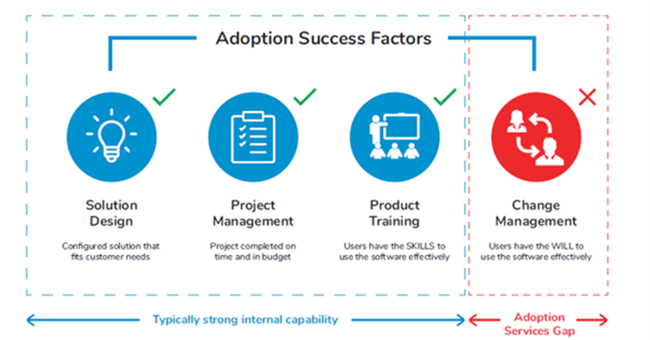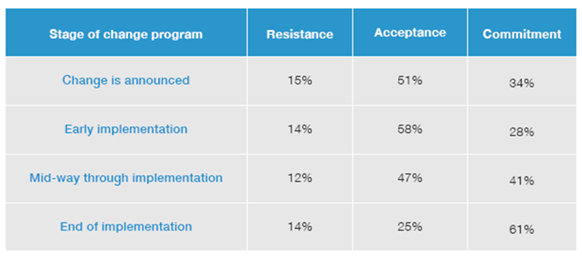
Back in October 2020 McKinsey published an excellent article that suggested recent levels of disruption had pushed companies over the technology tipping point – and transformed business forever.
Including the fact that executives were reporting that the share of digital or digitally enabled products in their portfolios had accelerated by 7 years. Yet, over 4 years on, enabling effective user adoption of technology remains as challenging as ever. With high levels of user adoption being the holy grail to getting full benefits and value from your Digital Workplace investment.
Everything begins and ends with the user, regardless of the change. And the key to success rests in:
- effective Change Management efforts i.e. getting to grips quickly with people-centred challenges and anxieties associated with a particular project
- understanding the contribution that your Change Management efforts can contribute to expected project benefits
So, what is your digital ROI looking like so far?
And what contribution is your Change Management making to it?
With the introduction of advanced technological capabilities like Artificial Intelligence (AI) and Machine learning, there may very well be obvious benefit inherent in the technology itself that is driving improved financial performance.
But, there will also be a proportion of ROI that is highly dependent on user adoption – which is reflected in confident usage with the knock-on effect on capability and productivity – of technology digital solutions. The type of things that are only truly that are realised through effective Change Management.
And very often that is the missing link for organisations trying to get true value from their technology investment. We call it the Adoption Services Gap and it is something that we explore in more detail in our Effective Change Management ebook.

What does Changefirst research data tell us about the issue?
At Changefirst we have a strong focus on identifying data that will help us better understand key Change Management issues.
So, what do the data highlights from 8,830 surveys across different organisations globally tell us about adoption? Here are some of the findings:
- With effective Change Management (i.e. focused resources and use of people data to inform project planning and delivery) a critical mass of commitment can be built up. To support projects in the hand-off to BAU. As shown in the table below where a structured approach to Change Management has been used to almost double commitment levels from 34% at change announcement to 61% at the end of the implementation as the project enters BAU.
 Source: Changefirst database, 8,830 surveys using Changefirst assessment tools
Source: Changefirst database, 8,830 surveys using Changefirst assessment tools
- At this level of engagement, data from our practitioner community points to more than 30% of project benefits coming from project investment in Change Management activities.
Of course, it is important to point out that this benefit contribution is not guaranteed. In fact, insights from our practitioner community also confirm that:
- less than 10% of project money is spent on Change Management activities
- this is in stark contrast to best practice in this area which suggests 15 - 20% is a more effective percentage
- it can also be difficult to sustain Change Management benefits through BAU because of 3 key infrastructure snags:
- leaders declaring victory too soon and diverting attention from projects
- end of year performance reviews and bonuses not reflecting change efforts
- deployments stalling in some roll-out areas e.g. with a slow capability uptake. So that early adopters lose interest in continuing to pursue goals
So, how do you ensure that your digital projects deliver ROI?
The easiest way to put this in context is to take inspiration from the real world.
Consider these two real customer examples – where we have removed names to respect confidentiality.
(a) Customer X - major digital transformation roll-out
Customer X, with an investment budget for major transformation in excess of £800m – affecting different business units, processes and included introducing digital technology to advance service delivery. Transformation project benefits excluding user adoption and behaviour change were just 37% - leaving a substantial contribution to project benefits to come from Change Management.
We worked with the client to deliver this, with activities including:
- development of early, active, sponsorship for softer interventions beyond structures and systems
- adoption of a new (networked) way of working to support technology adoption
- provision of scaled Change Management learning and tools on-demand to:
- develop and upskill local Change Hubs and Centres of Excellence (CoEs) quickly and cost-effectively
- facilitate workstream planning with a new integrated project and Change Management approach
- support transparency and dashboard reporting on delivery progress and emerging people risks
- Creation of a data-driven decision-making culture – validating the “word on the ground” with real people measures and benchmarking analytics to:
- better inform critical transformation decisions
- translate corporate rhetoric into action and continue to push new strategies safely to the front line
(b) Customer Y - Salesforce implementation and cost reduction
Customer Y had a goal to significantly optimize their cost structure across all enterprise functions with Salesforce being implemented as a commercial enabler to drive sales and marketing efficiencies. One of 3 main objectives of the project was to target global savings of USD1billion over a 4-year period.
Project benefits estimated to come from the technology and associated process redesign (i.e. benefits considered independent of people’s commitment and adoption of Salesforce and new Operating model design) were calculated at 43% - the remaining 57% of savings were highly dependent on delivering the people aspects of the project.
ROI (%) = project benefits – project costs
project costs
Not only was time of the essence for this customer, but they also needed to reduce the people-component of project costs by 25-30%.
To deliver against this the customer decided to:
- build an internal Change capability instead of using external consultants
- to buy-in & scale ‘out-of-the-box’ solutions from Changefirst that include learning and tools components (instead of re-inventing the wheel internally)
By providing digital access to tools and learning across a distributed network, they were able to yield a 40% reduction in costs associated with developing capability.
The other contribution to project benefits was to build a data-driven culture – quickly putting digital tools in the hands of 15% of the business globally. So that go/no-go decisions over a certain dollar value would also be informed by key people analytics to improve the quality of decision-making.
|
|
Is improving your digital ROI high on your Change Management agenda? If it is, then why not schedule a no-obligation discussion with one of our change experts around your needs? |




Leave a comment